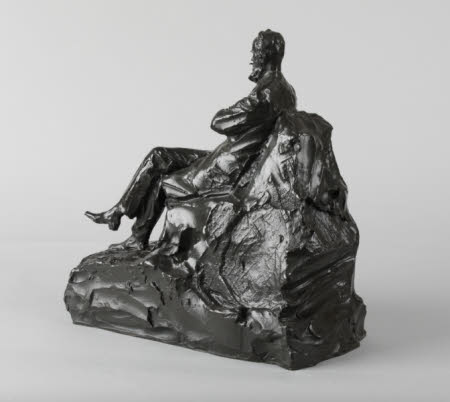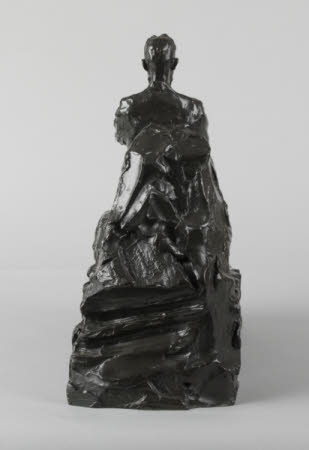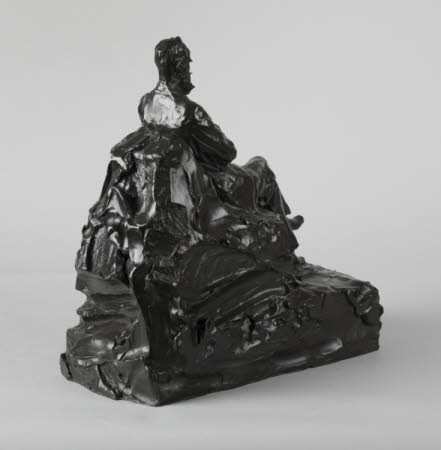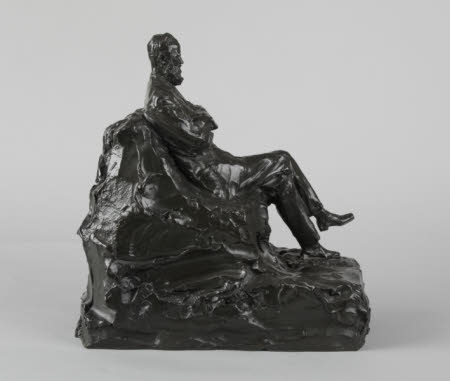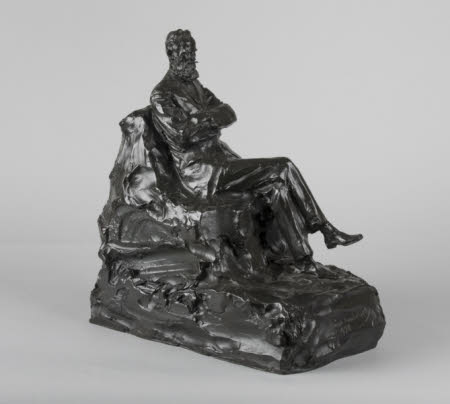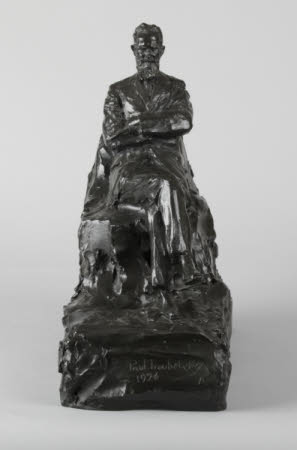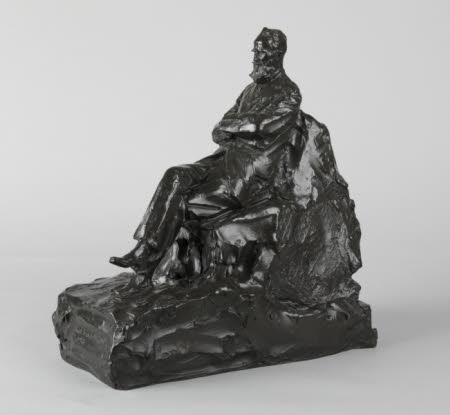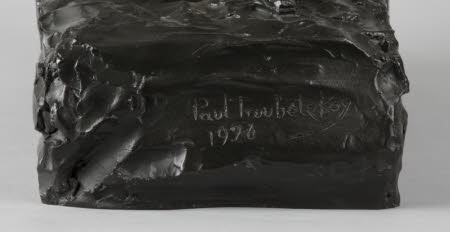Bernard Shaw
Prince Paolo (Paul) Troubetzkoy (1866-1938)
Category
Art / Sculpture
Date
1926 (signed and dated)
Materials
Bronze
Measurements
410 x 190 x 370 mm
Place of origin
Paris
Order this imageCollection
Shaw's Corner, Hertfordshire
NT 1274946
Summary
Bronze statuette of George Bernard Shaw seated (1856-1950) by Prince Paolo Troubetzkoy (1866-1938), sculpted in 1926. Shaw is seated with legs and arms crossed, wearing a suit. The seat is undefined and roughly modelled, rising directly from the base. Signed and dated, front of base: “Paul Troubetzkoy 1926”. The statuette was sculpted at Troubetzkoy’s studio on Lago Maggiore during July 1926, when the Shaws were on holiday at nearby Stresa, celebrating his 70th birthday. Shaw sat to the sculptor on three occasions: in 1907 for a portrait bust, in 1926 for this seated statuette (and for a portrait bust now at Tate Britain donated by Charlotte Shaw), and in 1927 when he posed for a life-size statue. Photographed by Ralph Morse in 1946 for Time & Life Pictures to celebrate Shaw’s 90th birthday (see Bernard Shaw through the camera, 1948, p.66).
Full description
Bernard Shaw greatly admired Troubetzkoy’s work, and the seated statuette of Shaw was sculpted at Troubetzkoy’s studio on Lago Maggiore during July 1926. Shaw and Charlotte were on holiday in Stresa on the shores of Lago Maggiore celebrating his 70th birthday. Troubetzkoy’s studio, the Villa Cabianca in Verbania, Pallanza was close by, and Shaw agreed to a number of extended sittings whilst they were staying there. The sittings resulted in this seated portrait, signed ‘Paul Troubetzkoy, 1926.’ Shaw so liked the portrait that he insisted on overpaying for it, noting that the cheque for 100,000 lira “probably does not even reward such beautiful work which will never be paid enough for its worth”. (John Grioni, “A Lifetime Friendship (George Bernard Shaw and Paul Troubetzkoy)” The Independent Shavian, vol.44, nos.1-2, 2006, p.7). Photographic self-portraits show Shaw posed with his seated statuette in Troubetzkoy’s studio in 1926, whilst the sculptor was at work. The life-size bust now in Tate Britain (donated by Charlotte Shaw in 1927) was also sculpted at this time. In 1927 the Shaws returned to Stresa, and Shaw again posed for Troubetzkoy at the Villa Cabianca, enabling him to create the standing full-length portrait that served as the model for the bronze statue that now resides at the National Gallery of Ireland in Dublin (purchased by the Gallery from Colnaghi in 1938). This sculpting session at Troubetzkoy’s villa featured in a British Pathé film entitled ‘George Bernard Shaw: Pathé cameraman induces the great dramatist hitherto most ‘screen shy’ of famous personalities to grant exclusive cine interview during holiday on Lake Maggiore.’ Shaw had first encountered Troubetzkoy’s work whilst he was an art critic in London during the 1890s, attending an exhibition of the sculptor’s “portraits and studies in oils”. The earliest sculpture by Troubetzkoy of Shaw was made in late 1907, created in just three hours in the painter John Singer Sargent’s studio. Troubetzkoy was driven to sculpt Shaw after seeing the bust of him by Rodin. Shaw recalled: “When Troubetzkoy saw the Rodin bust he said, ‘This face has no eyes. All Rodin’s busts are blind.’ He swooped down on me and demanded one sitting of half an hour…The half-hour of course meant three hours, and involved two sittings in Sargent’s studio, where Troubetzkoy flung clay about so recklessly that he covered not only himself but Sargent’s pictures and carpets with it…but the bust was a marvel as the result of three hours work; and as it made me flatteringly like a Russian nobleman I rather liked it.” (Shaw, quoted in Hesketh Pearson, Bernard Shaw: His Life and Personality, 1948, p.319). A bronze cast of this bust was made in 1908 and given to Charlotte, however she disliked it. Shaw eventually donated it to the Theatre Guild of New York, through his American producer Lawrence Langer. Shaw and Troubetzkoy were friends for over thirty years, a reflection of their shared love of animals and vegetarianism. In 1931 Shaw wrote the preface to Troubetzkoy’s London exhibition at Colnaghi’s gallery, where 3 bronze portraits of Shaw were on show. Shaw described Troubetzkoy as a “humanitarian who can do anything with an animal except eat it”, noting that “it is as a faithful vegetarian that I am immortalized in bronze in this exhibition.” (Shaw, ‘A Word’, Sculpture by Prince Paul Troubetzkoy, London, P.&D. Colnaghi, December 1931). For Shaw Troubetzkoy remained “one of the few geniuses of whom it is not only safe but necessary to speak in superlatives. He is the most astonishing sculptor of modern times.” The Shaws also owned two pencil drawings by Troubetzkoy made during sittings in 1926 and 1927, sold by Shaw in 1949. (Both are now in private collections). The plaster maquettes for all the Shaw sculptures are in the Museo del Paesaggio, Verbania Pallanza, Lago Maggiore, Italy. Only one other bronze edition of this seated portrait is known. (Alice McEwan, 2020)
Provenance
The Shaw Collection. The house and contents were bequeathed to the National Trust by George Bernard Shaw in 1950, together with Shaw's photographic archive.
Credit line
National Trust Collections (Shaw’s Corner, The George Bernard Shaw Collection)
Marks and inscriptions
Front of base: Paul Troubetzkoy 1926
Makers and roles
Prince Paolo (Paul) Troubetzkoy (1866-1938) , sculptor
References
Bernard Shaw through the camera : 1948., p.66

